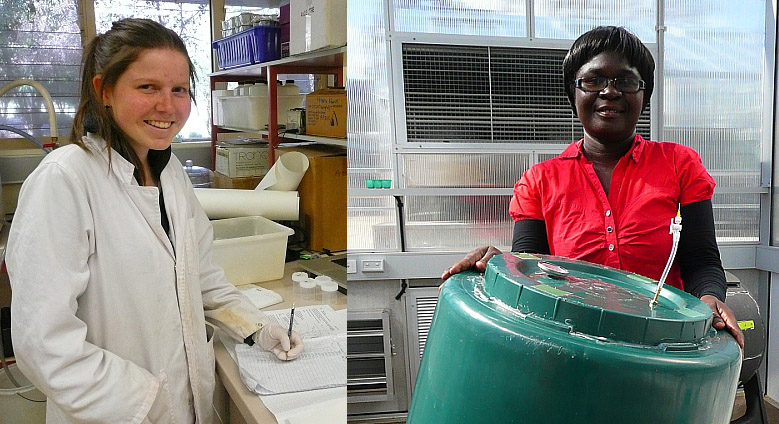POULTRY LITTER BIOCHAR: A MITIGATION STRATEGY FOR GREENHOUSE GAS EMISSIONS
Waste stream mitigation is becoming an increasingly important factor in any intensive animal production system, especially where the waste itself can be a valuable resource. One by-product of the poultry industry that fits this category is litter. Rich in essential plant nutrients such as Nitrogen (N), Phosphorus (P) and Potassium (K), poultry litter makes it an ideal candidate for fertiliser use. It has been estimated by Gollehon et al. (2001) that over 1.2 and 0.7 million tons of retrievable N and P respectively were produced in 1997 by the Australian livestock and poultry industries.

While poultry litter is rich in N, P and K, the bulky nature, odour and pathogens associated with its direct application to soil place it at a disadvantage. The bio-availability of these nutrients to plants with direct litter application is also not ideal; with much being lost to the environment via leaching and/or volatilisation. Indeed, composting raw litter releases greenhouse gases (GHG) such as nitrous oxide and ammonia.
Based at the University of New England (UNE) and under the supervision of Professor Annette Cowie at UNE, Poultry CRC PhD student Mrs Eunice Agyarko-Mintah is seeking to improve the fertiliser potential of poultry litter by incorporating biochar. Eunice explains, “Biochar is a product of biomass (in this case, poultry litter) placed under intense temperature with very little oxygen.” The resulting product is a nutrient-rich, stable and carbon-rich compound. In Eunice’ project, biochar will be composted with additional poultry litter, added to a variety of soil types and used in subsequent cropping trials.
“Basically the project will be co-composting raw poultry litter with poultry litter biochar” said Eunice. “Raw litter emits GHG’s when composted; but when added with biochar, the adsorption properties bind some of these in a form available to plants.” Adding composted biochar/poultry litter to soil can help improve soil structure, texture, and increase organic matter, porosity and cation adsorption capacity.
Eunice’ research will examine the impact of poultry litter compost, poultry litter biochar, raw poultry litter and poultry litter biochar compost on crop yield with two contrasting soils. She will also investigate the effect of the four treatments on nitrogen use efficiency and yield potential of a test crop (lettuce in this case) on two different soils, with the addition of NH4 / NO3 as stable isotopic fertiliser.
The potential real-world application of this innovative research is exciting. By quantifying and demonstrating the enhanced agricultural value of this product, Eunice’ research will aid in further development of this industry in future.
EFFECT OF DIETRY FATS/OILS ON ENERGY METABOLISM IN BROILERS
University of New England (UNE) Honours student Ms Melanie Pauvert is currently undertaking research on energy metabolism in broiler diets supplemented with various oils and fat. “We aim to increase omega-3 fatty acid content for consumers, and to see if there are any benefits to the growth of the chicken” explained Melanie. Specifically, her project aims to determine the effect of chain length and unsaturation (in oils/fats) on heat production, net energy and tissue fatty acid accumulation in broilers.
With support from the Poultry CRC, and under the supervision of Professor Bob Swick at UNE, birds are being fed diets containing different oils and fat including linseed, canola, fish-oil and tallow. These have been selected to give a range from saturated fat, to polyunsaturated fats with various concentrations of short chain omega-3 and omega-6 fats. These fats are said to be essential as we cannot produce them ourselves. Instead we must obtain them from our diet. Omega-3 is of particular importance as there are few sources in modern diets.

At 25 days of age birds will be placed in metabolism chambers for four days to measure metabolisable energy and heat production by closed circuit indirect calorimetry. Faecal matter, feed consumption, oxygen consumption and exhaled carbon dioxide levels will be analysed via this methodology. Each diet will be analysed for fatty acid content and will contain 7.5% and 8% oil respectively for starter and grower formulations. At day 35 breast and thigh muscle will be collected and fatty acid composition will be assessed.
Although Melanie is in the early stages of the research, she observes “Linseed is a likely candidate to produce the benefits of omega-3 without exhibiting a fishy taste or being too high in content.” The output of this project is to provide commercial broiler operations with economic and performance information relating to formulations utilising these various oils.


